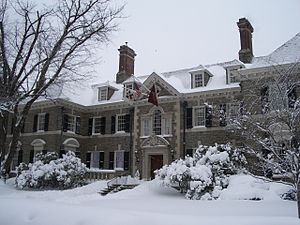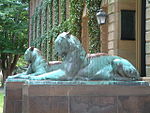- Princeton Charter Club
-
The Princeton Charter Club is one of Princeton University's ten active undergraduate eating clubs located on or near Prospect Avenue in Princeton, New Jersey, United States.[1]
Contents
Club history
The Princeton Charter Club was organized in the fall of 1901 as Princeton's ninth eating club, with a Senior Section from the Class of 1902 and a Junior Section from the Class of 1903. The name Cloister was at first selected until it was discovered that Yale already had an institution of similar name. About that time the document known as the Charter for the College of New Jersey was found and presented to the University. On the suggestion of Professor McDonald, an honorary member, the name Charter was substituted for Cloister. Charter's current neighbor to the west, Cloister Inn, later took the discarded name.
A small building on Olden Street—known as the "Incubator" because several other clubs had started there while they waited for sufficient finances to buy or build a proper clubhouse—was leased and the furnishing paid for by subscriptions.
In the spring of 1903 the Club purchased three lots and a house on Prospect Avenue which constitutes three-quarters of the present property. The house was redesigned and enlarged under the supervision of an undergraduate member David Adler of the 1904 Section, with the assistance of Professor Harris of the Faculty.[2] The funds for the purchase of this property and the alterations to this second clubhouse were raised by the sale of nineteen $1,000 mortgage bonds.
The so-called "Adler Clubhouse" would house Charter Club for a decade, until the present "Third Clubhouse", designed by noted architectural firm Mellor & Meigs[3] was completed in the fall of 1914. In the intervening years, Charter had grown into an institution of no small renown known for its extravagant banquets. Additionally, Charter's real estate assets had grown. In early 1905, at least one adjacent lot was purchased. In the summer of 1905, a squash court was built behind the clubhouse. The expansion of the land holdings encouraged the membership and graduate section of Charter to build the Third Clubhouse, which was and is a far more imposing edifice than either the Adler Clubhouse or most of Charter's peer institutions. Today, Charter is widely regarded as having one of the nicest clubhouses on "The Street."
After the United States entered World War I, Charter was temporarily closed due to reduced membership caused by widespread member enlistment in the armed forces. For a period of less than two years, between 1917 and 1919, the Charter clubhouse closed its doors, and Charter members left on campus received full membership privileges at Cottage Club. Charter lost seven members in the war, and their sacrifice is commemorated by a plaque located in the "Great Room."
Reopening in 1919, Charter quickly gained a reputation as a club personifying the era of the Roaring '20's. Known for its sophistication and its raucous bacchanalian moments, Charter Club carved a niche for itself on campus in the inter-war years.[4] At the notorious section party of 1930, thirty Charter members famously consumed four entire barrels of beer in the town firehouse, and decided to ring the fire bell, an action which drew a University proctor and minor disciplinary repercussions from the University after the intervention of the Charter Board of Governors on behalf of their younger charges.
World War II saw Charter closing along with all of its peer institutions, as members almost universally went off to fight abroad. Charter greatly expanded its membership after the war, but disaster struck closer to home in 1949 when a fire spread rapidly through much of the first and second floors causing heavy damage. A fire marshal summoned to the scene of the fire, on seeing the facade of Charter seemingly unaffected, declared famously, "I've never seen a building survive a fire like this, nothing's indestructible, but this place is damn close." Charter's membership has since often referred to it as "The Indestructible Charter Club," or simply "The Indestructible." As always, Charter recovered from this crisis as it has many in its history, throwing a famously lavish party to celebrate the completion of repairs and renovation in the spring of 1950.
Charter was known throughout the '50's and '60's for its hard partying ways—Charter parties were only rivaled at the time by those at perennial animal house Cannon Club. It is suspected, but not known, that at least one Charter member rode with members of Cap and Gown Club in the so-called Great Train Robbery of '63, in which the "dinky" train running from Princeton Junction into Princeton was forced to make a dramatic emergency stop after a car was seen on the tracks, at which point ersatz cowboys rode up to the train on horseback and carried off their dates who had been arriving for the weekend.
The greatest era of the Eating Clubs was beginning to fade by the late sixties, however, and looking to prop up stagnating membership figures, Charter announced that it would accept female members, over the objection of many members of the grad board, shortly after the University made the switch to coeducation. In 1977, Charter made the switch from bicker selectivity to sign-in openness in order to draw more members. The club remained financially stable throughout the 70's, 80's, and 90's, as six of its peers shut their doors permanently, no small accomplishment.
Throughout this tumultuous period, Charter never quite lost its carefree atmosphere and wild touch—best exemplified perhaps by the infamous Initiation Night of 1988. In 1988, Charter counted as members most of the Varsity Football Team, and many of the '89 section's officers were part of this particular group. It was some of these gridiron heroes who allegedly planned the raucous celebration of the admission of the new sophomore section which led to 45 members sent to McCosh Infirmary or Princeton Medical Center for alcohol-related reasons. The Princeton Borough Police quickly rounded up the Charter officer corps, and criminal charges were brought against the president and social chair, who were convicted of serving alcohol to minors, fined $500, and sentenced to 30 days in jail. The sentences were later overturned by a Mercer County Court judge, and the two undergraduate officers received probation and were ordered to perform community service.[5] To prevent a similar occurrence, but also to commemorate forever this fateful night, Charter now conducts formal initiations a week after all the other eating clubs, and on what would otherwise be initiation night officially "goes dry", although unsubstantiated rumors of a third-floor "speakeasy" often abound in the lead-up to this night. Initiation Night '88 is generally considered to be, along with the Section Party of 1930, one of Charter's most infamous moments.
Charter is known for excellent food.[6]
In February 2010, Charter Club led all sign in clubs with 118 first round sign-ins, compared to the 13 sign-ins of rival club Colonial. Currently, Charter and Terrace remain the most popular sign-in clubs on the street.[7]
In the fall of 2010, Charter announced major modifications to its membership admission system, creating a "weighted sign-in" system that gives preference to sophomores adjudged to be more enthusiastic about the club, based on their involvement in club activities and attendance at events open to sophomores. [8] In February 2011, operating under this new system, Charter was again the only sign in club to fill its sophomore section in the first round of sign-ins. [9]
Notable alumni
- David Adler (1904 Section), architect[10]
- Edmund Wilson (1916 Section), literary critic[11]
- José Ferrer (1933 Section), actor and film director[12]
- Mason Andrews (1940 Section), Physician [13]
- James Stewart (1932 Section), actor[14]
- Bowie Kuhn (1948 Section), former Major League Baseball Commissioner[15]
- Charles Fried (1956 Section), Harvard Law professor and former Solicitor General.
- Joel Rosenman (1963 Section), co-creator of the Woodstock Festival[16]
- Mitch Daniels (1971 Section), Governor of Indiana [16]
- Alan Greene (1981 Section), noted pediatrician and author[17]
- Joel Achenbach (1982 Section), writer [18]
- David Duchovny (1982 Section), actor [19]
References
- ^ Princeton University - ODUS - Eating clubs
- ^ Charter Club
- ^ Mellor & Meigs (fl. 1906-1916 and 1928-1941) - Philadelphia Architects and Buildings
- ^ Hometown Boy | The Jimmy Stewart Museum
- ^ The New York Times, Craig Bloom, "Clubs at Princeton Curb Drinking" 12 February 1989
- ^ More Than a Meal Plan - New York Times
- ^ http://www.dailyprincetonian.com/2010/02/01/24939/
- ^ http://www.dailyprincetonian.com/2010/09/20/26263/
- ^ http://www.dailyprincetonian.com/2011/01/31/27406/
- ^ Wilson, Richard (2002). The Styles of David Adler. The Art Institute of Chicago. pp. 20.
- ^ Baker, Carlos. "Edmund Wilson". A Princeton Companion. Princeton University Press. http://etcweb.princeton.edu/CampusWWW/Companion/wilson_edmund.html.
- ^ Dewey, Donald (1996). James Stewart, A Biography. Turner Publishing, Inc.
- ^ Krauss, Sam (October 20th, 2006). "Andrews '40 left mark on medicine". The Daily Princetonian. http://www.dailyprincetonian.com/2006/10/20/16294/. Retrieved 8 November 2010.
- ^ Hometown Boy | The Jimmy Stewart Museum
- ^ The Class of 1948 (May 9, 2007). "May 9, 2007 Memorials". Princeton Alumni Weekly. http://www.princeton.edu/~paw/archive_new/PAW06-07/13-0509/memorials.html. Retrieved 8 November 2010.
- ^ a b from Charter Club official records
- ^ Greene, Alan (2009). Feeding Baby Green: The Earth Friendly Program for Healthy, Safe Nutrition. Jossey-Bass. pp. 296. ISBN 0470425245, 9780470425244.
- ^ Achenbach, Joel (November 20, 2002). "Princeton the second time around". Princeton Alumni Weekly. http://www.princeton.edu/~paw/archive_new/PAW02-03/05-1120/perspective.html. Retrieved 8 November 2010.
- ^ Krattenmaker, Tom (May 7, 1997). "Before The X-Files". Princeton Alumni Weekly. http://www.princeton.edu/~paw/archive_old/PAW96-97/15-0507/0507feat.html. Retrieved 8 November 2010.
External links
Categories:- Princeton University
- Eating clubs of Princeton University
Wikimedia Foundation. 2010.


